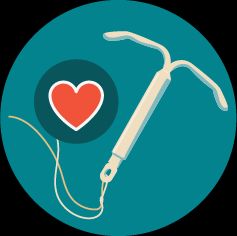If you feel your IUD, something may be amiss. Here’s what to know.
An intrauterine device (IUD) is one of the most effective forms of contraception. Fewer than 1 in 100 people who use an IUD will have an unplanned pregnancy.
A medical professional inserts an IUD into your uterus through your cervix. Once the insertion is complete, the IUD’s strings stay high up in your vagina. That’s so your doctor or nurse can remove the device when the time comes.
It’s natural to have questions about how an IUD might affect intimacy with your partner. Read on to get answers to common questions about IUDs and your sex life.
Neither you nor your partner should feel your IUD during sex, as the device is very small.
When properly inserted, the IUD rests inside the uterus, and only the strings are accessible in the vagina. They’re high up enough that you shouldn’t feel these either. However, it is sometimes possible to feel the threads of the IUD.
If you do feel the IUD, something may have gone wrong. It’s possible the IUD moved or wasn’t placed properly to begin with.
Talk with your doctor if you think you can feel your IUD during sex.
It’s rare for an IUD to fall out during sex or any other time. If it does happen, this is known as “expulsion”.
Sometimes, the IUD does fall out or move, but it’s not more likely to happen during sex than at any other time.
If it does come out of place, it’s most likely to happen during your period. (And still, it’s very rare.) Some doctors recommend checking the IUD’s strings once per month between periods to make sure it’s still in the right spot.
If the IUD has moved or falls out of the uterus, it no longer prevents you from becoming pregnant. It’s important to see a doctor to remove the IUD properly or reposition it correctly.
To be extra safe, you and your partner should avoid touching or accidentally pulling on the strings.
Your partner may feel your IUD strings, but this shouldn’t cause pain, as the threads are very thin and made of plastic.
If your partner can feel the IUD strings, it may be possible to shorten them, if this is something you’d like to do. However, you should consider a few things first.
Getting IUD strings trimmed
When you first get your IUD, the doctor or nurse practitioner trims the strings after the device is placed. If you want them shorter, they can trim the strings again at another appointment.
However, you may want to try waiting a bit longer. Over time, IUD strings become more flexible and often get tucked up next to your cervix. It’s also worth noting that having the strings cut shorter may make them stick out straight, which isn’t ideal.
Some doctors cut the strings completely or very close to the cervix.
While this may solve the problem of feeling the string, it can also make removing the device more challenging because the string is harder to grasp.
Your partner can orgasm inside your vagina. The IUD will still work to prevent pregnancy — it’s designed to stop you from getting pregnant even when there’s sperm present.
Depending on the type of IUD, it can
- preventing sperm from reaching the egg
- preventing sperm from fertilizing the egg
- preventing the egg from implanting in the womb
- causing the mucus of the cervix to thicken so sperm can’t reach the egg
- thinning the lining of the uterus
The IUD is highly effective at preventing pregnancy, but it doesn’t protect against sexually transmitted infections (STIs), which can lead to sexually transmitted diseases (STDs).
It’s recommended to use a condom with an IUD to reduce the risk of STIs.
Generally, people don’t realize when an IUD has moved out of place. By performing a self-check periodically, you may be able to feel if it’s not resting where it should be.
Your doctor should give you instructions on how to check the IUD at home. The steps may include the following:
- Wash your hands.
- Sit or squat.
- Place an index or middle finger into the vagina and touch the cervix.
- Feel around for the end of the strings.
There are a few signs that indicate when your IUD has moved:
- the strings feel longer or shorter than expected
- you can feel the hard part of the IUD against your cervix
- you feel the IUD at any time other than a self-check
- you experience pain, cramping, or bleeding
If anything about your IUD feels different, you can contact your doctor for additional advice and guidance.
If the IUD isn’t in the right place, it may not prevent you from becoming pregnant, and you’ll need to use another form of birth control.
You should always feel comfortable reaching out to a healthcare professional if you have any concerns. In particular, speak with your doctor if you experience any of the following:
- severe belly pain or cramping
- menstrual bleeding during intercourse
- pain during intercourse
- unexplained fever or chills
- unexplained or unusual vaginal odor or discharge
You can also talk with your doctor if you’re ready to consider pregnancy or if you want to change your method of contraception.
You should be able to become pregnant as soon as the doctor or nurse removes the IUD.
An intrauterine device (IUD) is a highly effective form of birth control. Neither you nor your partner should feel an IUD during sex, although your partner may feel the strings.
Although rare, IUDs can move. If you experience symptoms of this or think it may have moved, speak with a doctor.
If the IUD isn’t in the right place, it doesn’t protect against becoming pregnant, and you may need to use a backup form of contraception.





